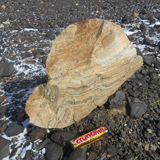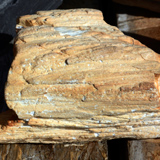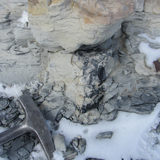Chert Rock
 And Antarctica at the time of the early Jurassic had actually moved northward from 80 degrees south latitude to about 60
degrees south latitude. And, also at the same time, we also have the break-up of Antarctica from Pangaea. And what we have
preserved here are slightly different deposits than these early ones. This is a rock type called chert. And if you look
very carefully, you can see some very fine line or laminations within this chert. And what we interpret these lines and
layers as being are basically lake sediments. What we can do is we can etch this rock with an acid, very strong acid.
And what that will do is bring out all types of organic material that is preserved within this chert. And what we find
when we do this is exquisite preservation of leaf fossils, as well as fossilized wood in this chert. Even though it is
not very pretty as a rock, when we actually look at this in the laboratory, we have just some of the most amazing
preservation of plant fossils in this type of sedimentary deposit.
And Antarctica at the time of the early Jurassic had actually moved northward from 80 degrees south latitude to about 60
degrees south latitude. And, also at the same time, we also have the break-up of Antarctica from Pangaea. And what we have
preserved here are slightly different deposits than these early ones. This is a rock type called chert. And if you look
very carefully, you can see some very fine line or laminations within this chert. And what we interpret these lines and
layers as being are basically lake sediments. What we can do is we can etch this rock with an acid, very strong acid.
And what that will do is bring out all types of organic material that is preserved within this chert. And what we find
when we do this is exquisite preservation of leaf fossils, as well as fossilized wood in this chert. Even though it is
not very pretty as a rock, when we actually look at this in the laboratory, we have just some of the most amazing
preservation of plant fossils in this type of sedimentary deposit.
Fossilized Wood
 This is a piece of Jurassic wood. And this is one that isn’t rotten, so it is great for anatomical studies, and Jurassic
wood is extraordinarily rare, especially seeing the rings in here. This is probably one of only maybe two or three pieces
ever found from Antarctica of Jurassic wood, so this is really incredible. And so this one will be cut up and looked at
for anatomical studies, so it will be looked at and described, as well as looking at the microbial components too; so
really great.
This is a piece of Jurassic wood. And this is one that isn’t rotten, so it is great for anatomical studies, and Jurassic
wood is extraordinarily rare, especially seeing the rings in here. This is probably one of only maybe two or three pieces
ever found from Antarctica of Jurassic wood, so this is really incredible. And so this one will be cut up and looked at
for anatomical studies, so it will be looked at and described, as well as looking at the microbial components too; so
really great.
Fossil Forest
 This is sandstone. And within this sandstone, we have these black blobby guys here. These are actually trees. These are
fossilized trees that I can turn around like this so you can see. This is an entire stem of an ancient tree that has been
preserved in a river of sandstone, fluvial sandstone. These were actually all upright when we found them. There are about
37 of these trees found upright like this with their roots attached. And that tells us that these trees were actually
preserved as they grew in the Triassic. It was a very important find, and we call that a fossil forest. And that helps
us understand a number of things. That helps us understand what kind of plants grew here, how the forest was structured.
And if we had these types of forests preserved over time, we can get a sense of how these forest communities changed over time.
This is sandstone. And within this sandstone, we have these black blobby guys here. These are actually trees. These are
fossilized trees that I can turn around like this so you can see. This is an entire stem of an ancient tree that has been
preserved in a river of sandstone, fluvial sandstone. These were actually all upright when we found them. There are about
37 of these trees found upright like this with their roots attached. And that tells us that these trees were actually
preserved as they grew in the Triassic. It was a very important find, and we call that a fossil forest. And that helps
us understand a number of things. That helps us understand what kind of plants grew here, how the forest was structured.
And if we had these types of forests preserved over time, we can get a sense of how these forest communities changed over time.
Fossilized Leaves
 These large black blocks here preserve essentially just leaf fossils and fossil seeds of a number of different types of
plants that grew around the middle Triassic in Antarctica. And at that time, Antarctica was roughly about 80 degrees south
latitude, so very high latitude polar vegetation. You can see this amazing preservation of these leaves. Here you can see
two branches connecting here. And these are very diagnostic of the type of plant called a seed fern; it is a type of plant
known as Dicroidium. And there is a bunch of different species of Dicroidium on the bedding plane. And another species of
a plant, or another genus actually, a Ginkgo plant here. So we actually have quite a bit of diversity of species as well
as plant genera on a single bedding plane. All these blocks show a very similar degree of preservation of these leaf fossils,
with great anatomical preservation of not only the leaves themselves, but let’s say a stem or a mid-vein and also the venation
of the leaves themselves. These are very helpful for us as scientist who determine what kind of plants these were, but to
also study how these plant characteristic may have changed through time to study how these plants may have evolved over
time as well. This preservation is relatively uncommon. It really is dependent on what kind of environment that these plants
were deposited in; we call that a paleo-environmental setting. These particular plants were actually deposited near a river,
near a meandering stream. And so they are deposited in a very quiet water setting that receives a lot of sediment in a rapid
period of time that allows these plants to be buried very rapidly, and that helped them to be preserved as nicely as they are.
This is another large block of a plant called Dicroidium, a seed fern.
These large black blocks here preserve essentially just leaf fossils and fossil seeds of a number of different types of
plants that grew around the middle Triassic in Antarctica. And at that time, Antarctica was roughly about 80 degrees south
latitude, so very high latitude polar vegetation. You can see this amazing preservation of these leaves. Here you can see
two branches connecting here. And these are very diagnostic of the type of plant called a seed fern; it is a type of plant
known as Dicroidium. And there is a bunch of different species of Dicroidium on the bedding plane. And another species of
a plant, or another genus actually, a Ginkgo plant here. So we actually have quite a bit of diversity of species as well
as plant genera on a single bedding plane. All these blocks show a very similar degree of preservation of these leaf fossils,
with great anatomical preservation of not only the leaves themselves, but let’s say a stem or a mid-vein and also the venation
of the leaves themselves. These are very helpful for us as scientist who determine what kind of plants these were, but to
also study how these plant characteristic may have changed through time to study how these plants may have evolved over
time as well. This preservation is relatively uncommon. It really is dependent on what kind of environment that these plants
were deposited in; we call that a paleo-environmental setting. These particular plants were actually deposited near a river,
near a meandering stream. And so they are deposited in a very quiet water setting that receives a lot of sediment in a rapid
period of time that allows these plants to be buried very rapidly, and that helped them to be preserved as nicely as they are.
This is another large block of a plant called Dicroidium, a seed fern.
 And Antarctica at the time of the early Jurassic had actually moved northward from 80 degrees south latitude to about 60
degrees south latitude. And, also at the same time, we also have the break-up of Antarctica from Pangaea. And what we have
preserved here are slightly different deposits than these early ones. This is a rock type called chert. And if you look
very carefully, you can see some very fine line or laminations within this chert. And what we interpret these lines and
layers as being are basically lake sediments. What we can do is we can etch this rock with an acid, very strong acid.
And what that will do is bring out all types of organic material that is preserved within this chert. And what we find
when we do this is exquisite preservation of leaf fossils, as well as fossilized wood in this chert. Even though it is
not very pretty as a rock, when we actually look at this in the laboratory, we have just some of the most amazing
preservation of plant fossils in this type of sedimentary deposit.
And Antarctica at the time of the early Jurassic had actually moved northward from 80 degrees south latitude to about 60
degrees south latitude. And, also at the same time, we also have the break-up of Antarctica from Pangaea. And what we have
preserved here are slightly different deposits than these early ones. This is a rock type called chert. And if you look
very carefully, you can see some very fine line or laminations within this chert. And what we interpret these lines and
layers as being are basically lake sediments. What we can do is we can etch this rock with an acid, very strong acid.
And what that will do is bring out all types of organic material that is preserved within this chert. And what we find
when we do this is exquisite preservation of leaf fossils, as well as fossilized wood in this chert. Even though it is
not very pretty as a rock, when we actually look at this in the laboratory, we have just some of the most amazing
preservation of plant fossils in this type of sedimentary deposit.
 This is a piece of Jurassic wood. And this is one that isn’t rotten, so it is great for anatomical studies, and Jurassic
wood is extraordinarily rare, especially seeing the rings in here. This is probably one of only maybe two or three pieces
ever found from Antarctica of Jurassic wood, so this is really incredible. And so this one will be cut up and looked at
for anatomical studies, so it will be looked at and described, as well as looking at the microbial components too; so
really great.
This is a piece of Jurassic wood. And this is one that isn’t rotten, so it is great for anatomical studies, and Jurassic
wood is extraordinarily rare, especially seeing the rings in here. This is probably one of only maybe two or three pieces
ever found from Antarctica of Jurassic wood, so this is really incredible. And so this one will be cut up and looked at
for anatomical studies, so it will be looked at and described, as well as looking at the microbial components too; so
really great.
 This is sandstone. And within this sandstone, we have these black blobby guys here. These are actually trees. These are
fossilized trees that I can turn around like this so you can see. This is an entire stem of an ancient tree that has been
preserved in a river of sandstone, fluvial sandstone. These were actually all upright when we found them. There are about
37 of these trees found upright like this with their roots attached. And that tells us that these trees were actually
preserved as they grew in the Triassic. It was a very important find, and we call that a fossil forest. And that helps
us understand a number of things. That helps us understand what kind of plants grew here, how the forest was structured.
And if we had these types of forests preserved over time, we can get a sense of how these forest communities changed over time.
This is sandstone. And within this sandstone, we have these black blobby guys here. These are actually trees. These are
fossilized trees that I can turn around like this so you can see. This is an entire stem of an ancient tree that has been
preserved in a river of sandstone, fluvial sandstone. These were actually all upright when we found them. There are about
37 of these trees found upright like this with their roots attached. And that tells us that these trees were actually
preserved as they grew in the Triassic. It was a very important find, and we call that a fossil forest. And that helps
us understand a number of things. That helps us understand what kind of plants grew here, how the forest was structured.
And if we had these types of forests preserved over time, we can get a sense of how these forest communities changed over time.
 These large black blocks here preserve essentially just leaf fossils and fossil seeds of a number of different types of
plants that grew around the middle Triassic in Antarctica. And at that time, Antarctica was roughly about 80 degrees south
latitude, so very high latitude polar vegetation. You can see this amazing preservation of these leaves. Here you can see
two branches connecting here. And these are very diagnostic of the type of plant called a seed fern; it is a type of plant
known as Dicroidium. And there is a bunch of different species of Dicroidium on the bedding plane. And another species of
a plant, or another genus actually, a Ginkgo plant here. So we actually have quite a bit of diversity of species as well
as plant genera on a single bedding plane. All these blocks show a very similar degree of preservation of these leaf fossils,
with great anatomical preservation of not only the leaves themselves, but let’s say a stem or a mid-vein and also the venation
of the leaves themselves. These are very helpful for us as scientist who determine what kind of plants these were, but to
also study how these plant characteristic may have changed through time to study how these plants may have evolved over
time as well. This preservation is relatively uncommon. It really is dependent on what kind of environment that these plants
were deposited in; we call that a paleo-environmental setting. These particular plants were actually deposited near a river,
near a meandering stream. And so they are deposited in a very quiet water setting that receives a lot of sediment in a rapid
period of time that allows these plants to be buried very rapidly, and that helped them to be preserved as nicely as they are.
This is another large block of a plant called Dicroidium, a seed fern.
These large black blocks here preserve essentially just leaf fossils and fossil seeds of a number of different types of
plants that grew around the middle Triassic in Antarctica. And at that time, Antarctica was roughly about 80 degrees south
latitude, so very high latitude polar vegetation. You can see this amazing preservation of these leaves. Here you can see
two branches connecting here. And these are very diagnostic of the type of plant called a seed fern; it is a type of plant
known as Dicroidium. And there is a bunch of different species of Dicroidium on the bedding plane. And another species of
a plant, or another genus actually, a Ginkgo plant here. So we actually have quite a bit of diversity of species as well
as plant genera on a single bedding plane. All these blocks show a very similar degree of preservation of these leaf fossils,
with great anatomical preservation of not only the leaves themselves, but let’s say a stem or a mid-vein and also the venation
of the leaves themselves. These are very helpful for us as scientist who determine what kind of plants these were, but to
also study how these plant characteristic may have changed through time to study how these plants may have evolved over
time as well. This preservation is relatively uncommon. It really is dependent on what kind of environment that these plants
were deposited in; we call that a paleo-environmental setting. These particular plants were actually deposited near a river,
near a meandering stream. And so they are deposited in a very quiet water setting that receives a lot of sediment in a rapid
period of time that allows these plants to be buried very rapidly, and that helped them to be preserved as nicely as they are.
This is another large block of a plant called Dicroidium, a seed fern.